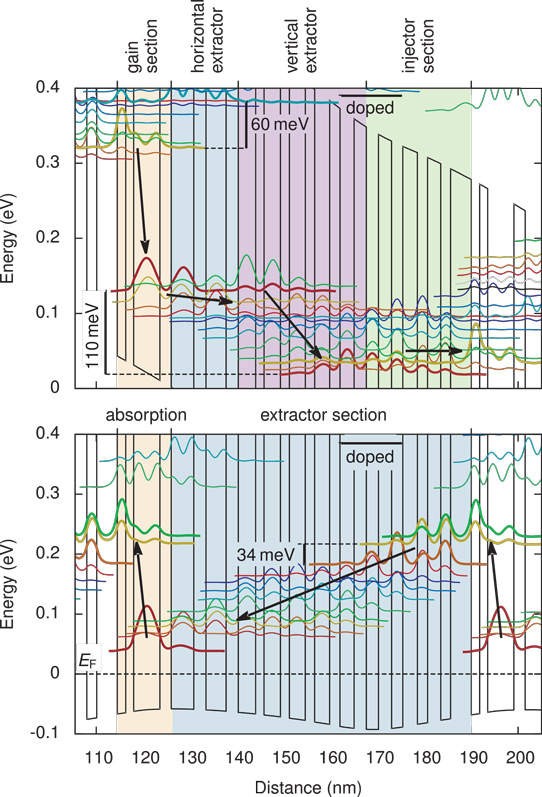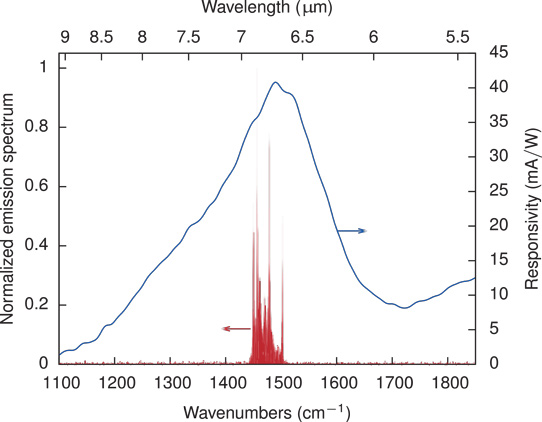- News
9 September 2015
Efficient combination of quantum cascade laser and detectors
Technische Universität Wien (TU Wien) in Austria has improved its bi-functional 6.8μm quantum cascade laser and detector (QCLD) technology [Benedikt Schwarz et al, Appl. Phys. Lett., vol107, p071104, 2015]. It is hoped that monolithic integration of quantum cascade lasers (QCLs) and quantum cascade detectors (QCDs) could lead to compact spectroscopy systems for environmental monitoring and medical applications in the form of trace gas sensing, blood serum analysis, etc.
However, combining efficient lasers and detectors on the same epitaxial material is a challenge since optimum designs for one mode tend not to be so for the other. Also, since the peak wavelengths are bias dependent, it is difficult to maintain spectral overlap between the laser emission and the detector's photo-response.
The TU Wien researchers comment: "Our previous designs showed room-temperature operation for both the laser and the detector, but were limited to low duty-cycle operation, due to the large threshold current densities and low wall-plug efficiencies." The team has refined its design to give a significantly higher laser performance and now claims that "bi-functional designs can achieve a comparable pulsed performance to conventional quantum cascade lasers".
The QCLD material was grown on indium phosphide (InP) using molecular beam epitaxy (MBE). The design included 35 periods of the active region (Figure 1) and two low-doped indium gallium arsenide (InGaAs) layers for confinement. The lasers and detectors were fabricated with 10μm-wide ridges, silicon nitride insulation, and annealed titanium/gold contacts. The devices were mounted epi-side up on copper with indium bonding.

Figure 1: Calculated band diagram of improved bi-functional QCLD for laser bias at maximal wall-plug efficiency (upper) and detector (zero) bias. Detector in thermal equilibrium with Fermi level denoted by dashed line.
The researchers report that the new laser device has improved all characteristic parameters by at least a factor of two over previous designs in pulsed mode (100ns at 10kHz). With a 3mm-long Fabry-Perot ridge, the room-temperature current threshold was 3kA/cm2, compared with 6kA/cm2 for a previous QCLD device technology. At the same time, the optical output was 470mW (200mW, previously). The total wall-plug efficiency was 4.5%, which falls short by a factor of two or three compared with conventional QCLs with comparable waveguide structure. Some groups have achieved wall-plug efficiencies of up to 50%.
The team comments: "Further improvements can be achieved by applying high- and anti-reflection coatings on the facets, as well as by using buried heterostructure waveguides with InP cladding to decrease the waveguide losses and increase the heat dissipation."

Figure 2: Overlap of emission spectrum and spectral responsivity of QCLD structure.
For the detector section, the peak response was 40mA/W at zero bias with a 0.5mm-long ridge (Figure 2). The differential resistance of 1.6kΩ gives a Johnson/thermal noise equivalent power (NEP) of 80pW/√Hz at the peak wavelength. The researchers point out that they were limited to 0.5mm ridges due to the cleaving process. Lithography and dry etch could be used to decrease the length. The team comments: "A length of 15μm would give the optimal Johnson-noise-limited NEP, while slightly longer devices around 50μm give a higher responsivity and are favorable if the noise is limited by other sources."
In an on-chip configuration with a small air gap between laser and detector, the peak absolute photocurrent was 9mA without saturation.
Quantum cascade detectors InP InGaAs MBE
http://dx.doi.org/10.1063/1.4927851
The author Mike Cooke is a freelance technology journalist who has worked in the semiconductor and advanced technology sectors since 1997.


